This was published 7 years ago
Ultimate hotel destinations: 10 of the world's dream hotels
Try this simple exercise. Imagine yourself asleep in your dream hotel. You wake up, open your eyes – now describe what you see. That, in essence, is the task assigned to a group of Traveller writers. The results? Well, they prove the ultimate accommodation comes in many different forms.
For some, it is what's outside that matters. They focus on the joy of feeling adrift in the sea that comes from sleeping in an overwater bungalow, and about the freedom that comes from being enveloped by wilderness. Apparently being woken in the night is not necessarily a bad thing, at least not when it is roaring lions that are doing the disturbing.
For others, the perfect property is one that offers a feast for the senses. That might be a literal feast served up by an acclaimed chef, or a cultural feast, with museum-worthy art hanging on the walls. Then there are the properties that take a more pared-back approach: the streamlined simplicity of a classic Japanese ryokan, for example, or even the no-fuss freedom of a simple canvas tent.
All of which is a reminder that, whatever your travel style, there is an accommodation option that will make you feel perfectly at home.
THE FOOD TEMPLE
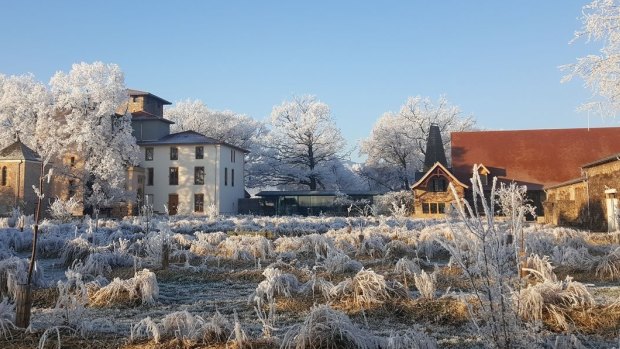
By Ute Junker
Some hotels are all about what's in the room: designer furniture, oversized beds and bathtubs, silky-soft bathrobes. At some of my favourite hotels, however, what really counts is what's on the plate.
There are plenty of hotels with good restaurants, but at the properties I am thinking of, the food is the focus. You come here to eat; the rooms are merely a welcome convenience. In many cases, the restaurant actually preceded the rooms.
Take Maison Troisgros in Roanne, the legendary French restaurant that has held three Michelin stars for almost half a century, and now also offers 16 elegant guest rooms.
Then there is Le Suquet, founded by another celebrated chef, Michel Bras. Bras built his reputation with signature dishes such as the gargouillou of young vegetables, which celebrate the local produce of the Auvegerne region. The hotel, with its floor length windows, also puts the landscape front and centre. In Australia, the sumptuous Lake House, run by the Wolf-Tasker family, also celebrates local producers and the local area – in this case, Victoria's picturesque Daylesford region.
At most of these properties, the presence of the chef is an integral part of the property's charm. Occasionally, however, a hotel manages to become a foodie beacon even without the presence of a hands-on chef. Top of the list is the Hotel Metropole Monte-Carlo, where no fewer than four eateries are run by the legendary French chef Joel Robuchon.
Bring your appetite; at a minimum, you will want to eat at Yoshi, the Michelin-starred Japanese eatery, and at the hotel's signature eatery, Restaurant Joel Robuchon. Meals at this double Michelin-starred eatery begin in spectacular fashion when a wooden trolley laden with half-a-dozen different sorts of bread rolls is wheeled to your table.
Robuchon's cuisine blends Mediterranean influences with Asian touches; your meal may include john dory with shiso leaf tempura, or a deconstructed Provencal cepes tart. At the end of the meal, the trolley puts in an encore appearance, this time laden with a selection of mouthwatering desserts.
However, the highlight of any stay at the Hotel Metropole, or at any of these culinary palaces, for that matter, is not the evening meal. It's the delight of waking up in the morning and knowing that at this hotel, breakfast – all too often an underwhelming experience – is going to be gourmet adventure. At the Metropole, hot chocolate fans can choose between French and Italian style beverages; if you order boiled eggs, they will arrive already peeled. Merci, Monsieur Robuchon.
See metropole.com
THE MOUNTAIN HUT
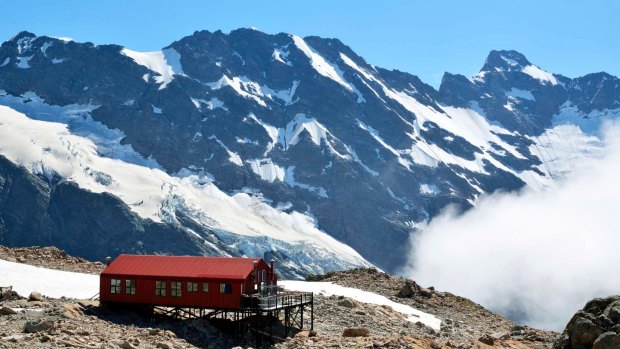
Credit: iStock
By Andrew Bain
Snow was piling up outside the door of the mountain hut. For six hours it had been unceasing, painting the land white and confining us to this most basic of log shelters inside Tasmania's Walls of Jerusalem National Park.
Our tents sat unpacked inside our backpacks, and the clothes we'd hung to dry by the door would soon be frozen stiff. By morning it would be an effort to open the door against half a metre of fresh snow.
Lying back in our sleeping bags through the winter afternoon, with our camp stove bubbling with coffee and the world outside being transformed into Narnia, there wasn't a hotel or resort in the world that could compare – it was luxury whittled back to its purest, most elemental form.
Hotels rarely save lives, but mountain and hiking refuges do. They huddle in wild reaches of the planet, offering shelter against storms, blizzards and other crazy weather. And when conditions are fine, they typically come with million-dollar views at pauper prices – often for free.
At their most basic form they are emergency shelters, offering a place to sleep only in the most threatening or dire of circumstances. These shelters can be cramped, dark, uncomfortable and cold, yet they're also a salvation. I've sheltered from powerful overnight storms in huts in the Walls of Jerusalem and Mount Field national parks in Tasmania, and along the Main Range in Kosciuszko National Park, and each one remains among my most cherished memories of time on the trail. Hotels have never been as memorable.
Not all huts are primitive. Across the European Alps, where there are more than 3000 mountain huts, they're often de facto hotels, complete with bars, outdoor terraces with jaw-dropping views, and private bedrooms. All that ultimately distinguishes them from hotels is that they can usually only be reached on foot.
They sit as high as 4500 metres above sea level on Monte Rosa, the Alps' second-highest peak, where Margherita Hut serves up half-board and free Wi-Fi. The 120-year-old Triglav Lodge in Slovenia is a five-hour walk from any road and yet it sleeps 300, and can feed the same number in its handful of restaurants.
In Patagonia I've shielded from 160km/h winds in a mountain hut, watching the wooden walls warp but never yield, but also casually sipping pisco sours and waiting for a three-course dinner. New Zealand's Mueller Hut, a basic, bunk-only building in the Southern Alps, has arguably the finest view of any accommodation in the country, staring through the Hooker Valley to Mount Cook.
Nor is Australia now confined to just basic mountain huts. On Tasmania's Three Capes Track, the hut experience has evolved to pseudo-resort status, with the three stylish, architect-designed huts featuring sun decks with canvas chairs and yoga mats, libraries of books, gas stoves and USB phone chargers.
What unites the hut experience across the world is that wonderful earned-through-effort pleasure of dumping your backpack and feeling the little luxuries grow big. Dinners have never tasted so good, and beds have never been so welcome, even if there's no pillow let alone a pillow menu. See threecapestrack.com.au/
THE OVER-WATER TROPICAL BUNGALOW
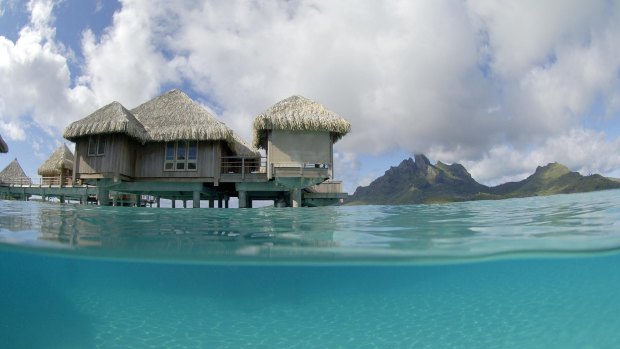
By Craig Tansley
Can there really be a more decadent type of accommodation? Nothing screams S-E-X-Y quite like an overwater bungalow; little wonder then that they're the choice of abode for rock stars and Hollywood icons on much publicised romantic trysts.
When you book an overwater bungalow you need never worry if your room will have a view of the lagoon … because you're sleeping right on top of it. You're a part of the marine world in an overwater bungalow – the foundations of your room are actually set down there below the surface with the fish, the rays, the turtles and the coral you've come all this way to see.
And where other hotel rooms – even the most expensive rooms on this earth – demand at least a short stroll for a swim, all it takes is a jump from the back deck of your overwater bungalow to be in the sea.
Though for all their luxurious attributes (glass panels on the floor beside your bed so you can look down at the fish below, sea views from every window, even your toilet) – it's climbing the ladder back up from the lagoon to my bungalow that I look forward to most when I stay in overwater bungalows; for it always feels just like I'm stowing away on my own private ship.
But then, sleeping in an over-water bungalow is the closest thing any vacationer can get to sleeping on a boat … without actually sleeping on a boat. I once sailed through the Society Islands of French Polynesia on a 15-metre catamaran, ending my voyage on Bora Bora. When I disembarked, I moved into an overwater bungalow and it was like I'd never left the boat. Each morning I still woke to a horizon of blue ocean; although my overwater bungalow didn't once rock with the swell; and so it comes with a guarantee of no seasickness, or shipwrecks.
Overwater bungalows were invented in Bora Bora (they turn 50 this year) and I think there's still no better place on Earth to truly admire them (the overwater bungalows at the St Regis Bora Bora Resort are my favourite). Other islands might try, but it's hard to replicate that sunset across Mount Otemanu, or the electric sheen to the blue of this lagoon. And isn't there something about having the choice between paddle-boarding or swimming to the breakfast table each morning?
THE ART HOTEL
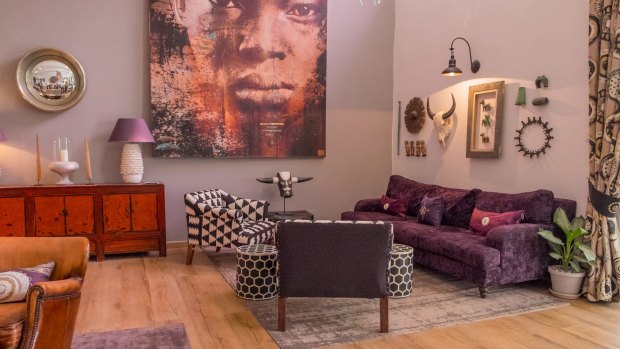
Credit: Gareth Bentley
By Catherine Marshall
I want to move permanently into Latitude 15, to make it my very own home. Or at least to have a suite set aside for my own personal use, as per Hemingway at the Ambos Mundos in Havana and Coco Chanel at the Paris Ritz. For Latitude 15 is nothing like a hotel. It possesses none of the uniformity that must, by necessity, be incorporated into the design of such public lodgings. It is devoid of the sterility that plagues so many large hotel chains, of the neutral spaces into which an endless stream of anonymous guests must be able to comfortably insert themselves.
It is housed not in a standard-issue skyscraper but in a low-slung, modernist dwelling hidden behind suburban walls and cushioned within the fecundity of Kabulonga, the embassies-and-consulates suburb of Zambia's capital city, Lusaka.
No, this is not at all like a regular hotel. Rather, it's like the home of an exceptionally stylish friend, one whose home is identical to the one I had imagined for myself, whose taste in art perfectly matches my own. It's as though it has been built with my own design sensibility in mind: full of light and colour and whimsy – and a surprise tucked around every corner.
This place evokes the sense of belonging I've felt elsewhere, at the Sofitel So Singapore (sofitel-so-singapore.com), adorned with psychedelic artworks and dotted with objects designed by fashion designer Karl Lagerfeld; at Benesse House (benesse-artsite.jp/en) on the Japanese island of Naoshima, where vast concrete walls are hung with works of contemporary art.
It's this shirking of convention that makes art hotels so appealing, the audaciousness of selecting works that might not charm guests at all. At Latitude 15 such resoluteness is achieved with polished concrete floors reminiscent of both African verandas and industrial warehouses; walls hung with contemporary African artwork – juju hats, cow bells, a dystopic oil hexaptych – and rooms filled with precious artefacts; dangling lampshades sculpted from seeds; bathroom screens made from fragments of glass; cushions covered in modern African prints. (Many of the soft furnishings come from the nearby Jackal and Hide, where guests can shop for their own designer keepsakes. See jackalandhide.net.)
To be sure, the art hotel cannot please everyone, for it is by its very nature infused with subjectivity. But when it does, you'll want to move in and make it your home.
THE SAFARI LODGE
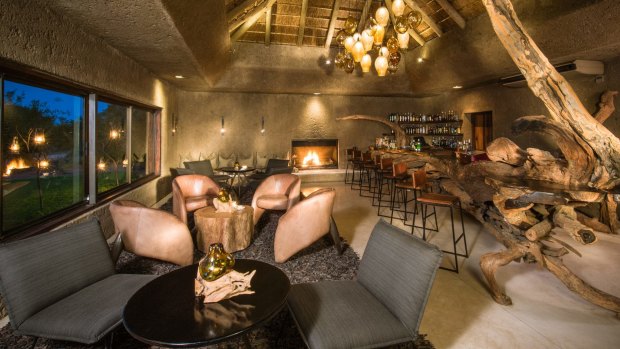
By Rob McFarland
Unlike most types of accommodation, the job of a safari lodge is not to cocoon you from the outside world but instead to immerse you in it. And it's this feeling of being part of the landscape that makes them so intoxicating.
Every day brings a fresh assault on the senses – the spine-tingling sound of lions roaring in the night; the pungent aromas of earth, grass and wood smoke; the feel of cool stone floors, rough timbers and animal skins.
Every lodge has its own way of achieving this. At Singita Lebombo, an upscale property in a private concession bordering South Africa's Kruger National Park, there are outdoor showers where one morning I could have reached out and touched the horns of a grazing antelope. Loisaba in northern Kenya has Star Beds, four-poster beds on raised wooden platforms that allow you to sleep in the bush under a glittering African sky.
Jawai, a luxurious tented property in Rajasthan in India, offers sundowners on rocky outcrops and dinners in lantern-lit clearings around a roaring fire.
The best safari lodges combine this sense of immersion with spectacular accommodation, flawless service and gourmet cuisine. One that stands out is Earth Lodge, the most exclusive of the four properties in 5000-hectare Sabi Sabi Private Game Reserve in South Africa.
Invisible on approach, a narrow, winding passageway leads to a striking, contemporary lodge decorated in earthy African tones with arresting wooden sculptures by South African artist Geoffrey Armstrong.
All 13 of its suites have private plunge pools and glass-fronted ensuite bathrooms with egg-shaped stone bathtubs. There are no fences so guards accompany you on the nerve-wracking torch-lit walk to and from the main building after dark.
The food is both remarkable and relentless – sumptuous breakfast buffets, delicious lunchtime soups and salads, decadent afternoon teas and extravagant four-course dinners paired with wine from a 6000-bottle cellar.
And let's not forget the reason you go on safari in the first place – the opportunity to observe animals in their natural habitat. That feeling of anticipation when you hop into the back of a jeep at dawn – smothered in rugs and cradling a flask of hot coffee, ready to head into the bush in search of game – is second to none.
See sabisabi.com
THE JAPANESE RYOKAN
By Julie Miller
Our host at the Masuya ryokan in the spa village of Yudanaka-Shibu in the Japanese Alps is quite adamant: we must wear our freshly donned yukata (traditional cotton kimonos) and geta (wooden flip-flops) into the cobblestone streets, despite sub-zero temperature outside.
"Go, go!" she insists, much to my teenage daughter's mortification. "Tourists like! Go!"
Unfortunately, we are more clomping Clydesdales than shy geishas, shuffling awkwardly in the cantilevered platforms and roaring with laughter at our cultural ineptitude. But we are happy to embrace the comical moment, which represents just another endearing ritual of a ryokan visit.
For a taste of insular Japan, an overnight stay in one of these traditional guesthouses – arguably the most culturally pure style of accommodation on the planet - is an unforgettable experience, offering an insight into this country's customs, food, design and sensibilities.
The concept of Japanese hospitality dates back 1300 years, when rest houses were first established by monks to provide weary pilgrims a safe haven. Later, as travel became more commonplace, more sophisticated private inns were built, catering largely to feudal lords and merchants travelling along the Tokaido Highway between Edo (current-day Tokyo) and Kyoto.
To welcome these esteemed guests, local hosts offered bed, dinner and breakfast, a tea service, robes to relax in and access to bathing facilities in an on-site onsen – the model for the modern-day ryokan.
Minimalism is at the core of the Japanese aesthetic. A typical ryokan is sparse; there's a coffee table, set on arrival with tea, legless chairs called zaisu, a bar fridge and perhaps a television. Sliding rice-paper doors separate an entry area and the bathroom from the main room; and during a set kaiseki dinner, served in a communal dining room, futons are rolled onto the floor for sleeping, topped with cloud-like doonas for warmth.
Hidden closets – how is it that the Japanese notion of storage is so aesthestically pleasing? – conceal all linen, as well as the cotton kimonos, which guests are encouraged to wear in their rooms, in public spaces (including to and from the communcal hot baths), and indeed, even outside.
And true to our landlady's word, tourists do like – in fact, in recent years, the traditional ryokan has regained popularity as western visitors seek authentic, culturally-enriching experiences. While they are not the cheapest places to stay – guests are charged per person, rather than per room – there's no better place to experience Japan in all its weird and wonderful glory.
See masuya-yushinan.com or visit a ryokan booking website such as japaneseguesthouses.com
THE WILDERNESS LODGE
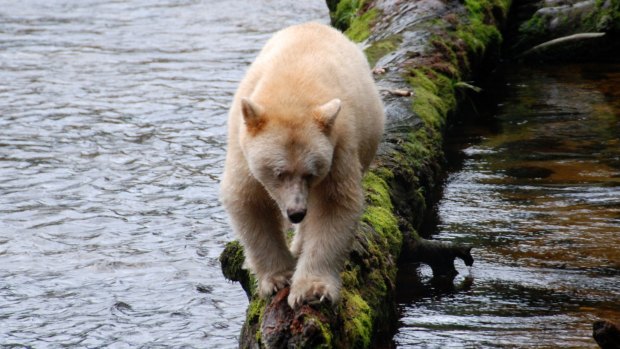
By Kerry van der Jagt
The sun is at your back as you push off in the kayak, oars rising and falling, eyes scanning the riverbank for wolves. Or, from the comfort of your deck you watch a herd of elephants, drinking and bathing at the water's edge. Or perhaps you arrive at your lodge by float plane, the only way in and out of polar bear territory.
Given the choice I'll hunker down in a wilderness lodge over any other style of accommodation. One where I can step from my room and be swallowed by the landscape, where conservation and research are more important than bed linen and thread count, and where environmental and cultural concerns dictate design and location.
From Tasmania's ecologically aware Bay of Fires Lodge to New Zealand's remote Shearwater Lodge, the best share the same traits; jaw-dropping locations, small number of guests, passionate naturalist guides and meals created from local, seasonal food.
I've hiked to both of these lodges, as part of three- and four-day itineraries, the effort and exclusivity adding another layer to the experience.
Canada's Spirit Bear Lodge, off the coast of British Columbia in the midst of the Great Bear Rainforest, took even more effort – a flight from Vancouver to Port Hardy, another one to Bella Bella on Campbell Island, an overnight stay at Shearwater followed by a two-hour boat trip to Swindle Island.
Stepping ashore onto the floating platform was like slipping through a portal to a parallel world. One that is challenging and life changing, where anything can happen and nothing is scripted. Operated by the Kitasoo/Xai'xais First Nations the 12-room, waterfront lodge is cosy and comfortable, with an enormous dining room, a mud room for changing into expedition gear and a communal lounge for lectures.
On one afternoon we took zodiacs to Mussel Inlet where we crouched against moss-covered logs, watching grizzlies teaching their cubs to catch trout. On another we visited Kynoch Falls with a Kitasoo/Xai'xais guide, kayaked to an ancient burial ground, cruised alongside humpback whales and laughed at the antics of sea otters.
Later we gathered in the lounge, listening to talks about poachers and pipelines before walking to the Kitasoo/Xai'xais meeting hall for an impromptu performance. In a nutshell, this is what wilderness lodges are all about and why I travel to the remote edges of the earth.
See spiritbear.com
THE TENT
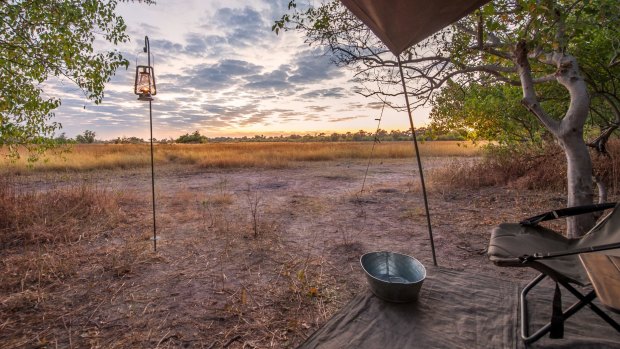
Credit: iStock
By Ben Groundwater
It's all about the sunset. Every day the mere dipping of the sun below the horizon is an exciting event, an excuse to pause and watch and appreciate this routine display of natural splendour.
Sometimes you do it mid-stride while you're out exploring, glancing up at the painted sky and commenting to someone nearby about now beautiful it is. Other times you enjoy it from the comfort of a camp chair, gin and tonic in hand, dinner bubbling on the stove, gazing into the distance at your leisure.
When you're camping, you never miss a sunset. It's always an event. When you're living outside it never goes unnoticed, never slips away unappreciated.
And that's what camping is all about. Not the canvas walls. Not sleeping on the floor. The true glory of staying in a tent has nothing to do with where you lay your head – it's all about where you spend the rest of your time: outside.
No sane person would argue that a tent is more comfortable than an overwater bungalow or a safari lodge. But that's not the point. When you camp, you're doing it in some of the most spectacular parts of the world, and it's a world you're forced by the very nature of your accommodation to throw yourself into and enjoy.
Picture this: Moremi Game Reserve, in Botswana's Okavango Delta. There are luxury safari lodges here, places that are off-the-charts expensive, with wood-floored rooms where you'll sleep between crisp cotton sheets and be awoken each morning with coffee and biscuits.
But camping is better. I'm staying at a site called Third Bridge, accessible only by 4WD, a little gathering of tents and campers huddled together in the wild, with no fences, no electricity, no rangers with guns for protection.
Elephants wander through every day. You have to keep your eyes open – it's amazing how a group of 6000-kilogram pachyderms can just blend into the scenery. Lions roar at night. Hyenas skulk about in the shadows while you prepare dinner, hoping to grab some scraps.
This is adventure. This is living. We spend our days driving around the park looking for the "Big 5". In the afternoon we set the tent up, get the campfire ready to light, arrange the chairs on the grass and pull a few beers out of the esky.
Tonight, elephants might walk through camp, right in front of our fire. Jackals will dart in. Baboons will howl. Eyes will stare at us from the darkness. And we won't miss any of it. Right now, however, all of those events pale in comparison to nature's big show, to the highlight of every single day that's about to occur once again: sunset.
THE HOUSEBOAT
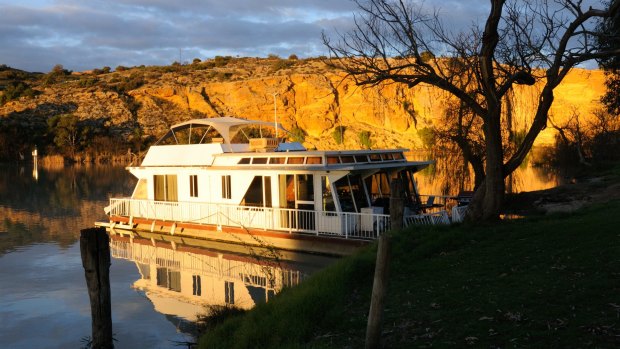
Credit: iStock
By Steve Meacham
How good can a houseboat adventure get? We're here on the Murray, a river that has shaped and divided Australia. My mutinous crew consists of two grossly insubordinate sons. They're more than happy to take the wheel, select the best mooring spots, bask in the upper deck spa, chart our voyage ("How far can we get in a week, Dad? Echuca? The South Australian Bight?"), leap overboard in the tea-coloured water or spend an hour fishing.
But make breakfast? Clean the heads (toilets to you landlubbers)? Tidy their cabins?
I recently asked my sons what holidays they most wanted to repeat. Both nominated houseboat holidays, albeit different trips and different countries.
Sure, the boys have had more exotic vacations (African safaris, Rocky Mountain skiing, Tuscan villas) but there's something beautifully bonding about sharing a few days afloat.
I love it all.
Passing the obligatory safety briefing and demonstrating you're at least competent enough to cast off. Stocking up on ship's stores, including treats that would be banned at home. Sitting at the wheel and getting used to the remarkably relaxing pace that comes with a maximum speed of 8 knots an hour.
Discovering the local wildlife with the help of the onboard guide books. The joy of finding a perfect place to moor overnight - preferably somewhere peaceful but within walking (or rowing) distance of a charming riverside pub that's served boat people for generations.
My first houseboat, back in 1989, set an impossibly romantic standard – is there anywhere on earth more beautiful than Dal Lake, the so-called "Jewel in the crown of Kashmir"?
For a few rupees, we hired one of those wonderful cedar-wood "floating palaces" for four days, with its lavishly rugged rooms, handsome verandah and sun deck with unforgettable views across the serene blue waters to the surrounding Himalaya. (Visitors to Srinagar today should check smartraveller.gov.au before booking.).
Subsequently, I've hired houseboats in Britain (the River Thames, the Grand Union Canal, the Norfolk Broads), France's Canal du Midi, and Peru's Amazon. They've all been nothing less than an adventure.
But we have great waterways to explore here in Australia, and where better to start than the third longest navigable river in the world after the Nile and the Amazon: our very own Murray.
Shannon, the Murray houseboat we hired, sleeps 2-10 from $950 for three nights.
See allseasonshouseboats.com.au
THE TREEHOUSE
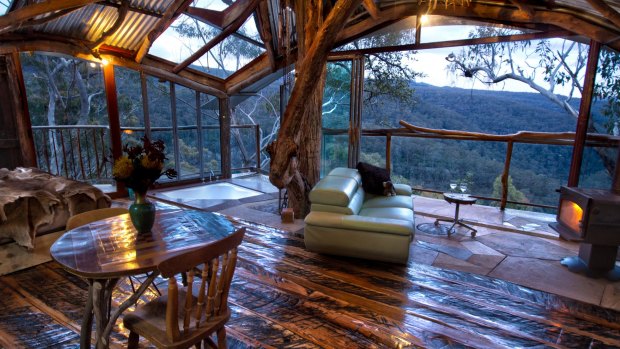
Credit: Jochen Spencer
By Nina Karnikowski
My love affair with treehouses started early. At age five, I helped my big sister pull a thick plank of wood out of dad's shed at the back of the garden, and balance it from a rock ledge into the boughs of the jacaranda tree opposite. Our first treehouse never got more fancy than that. Yet in our imaginations it became all the places we longed to go; a turreted castle, a majestic watchtower, a sailing ship.
Today, almost three decades later, the treehouses I stay in are crafted from much more than leftover scraps from dad's shed. But the sense of whimsy, fantasy and freedom that treehouses hold still draws me to them over all other forms of accommodation.
The feeling that, the moment you step over the threshold (or climb up the last rung of the ladder, as the case may be), you have every excuse to morph into a dreamy kid playing make-believe again.
Which is exactly what my husband and I did upon arriving at the luxurious Secret Treehouse in the Wollemi Wilderness area of Bilpin, NSW, mid-last year. KEEP OUT, NO GROWNUPS, read the yellow hand-painted sign hanging on the wooden front door of this hideout, hovering ten metres above the ground and skilfully crafted from local felled timber and recycled materials like corrugated iron and sandstone.
Keeping the door's message in mind, we threw the floor-to-ceiling windows open to the rain and towering eucalypts, jumped in the hot tub, popped the champagne, told each other tales and giggled like kids all night long. High in the rain-lashed treetops, with the potbelly fire crackling away in the corner, we forgot completely about the outside world. Better than that, it seemed to forget completely about us.
Nowhere else have I felt as immersed in nature than in a treehouse. In Samoa's Upolu hinterland we were swept off our feet by Samson, a 300-year-old banyan tree that's home to a two-storey treehouse at Lupe Sina Treesort. We showered inside Samson's dripping root system; we slept in his arms. In the lounge room his limbs reached through the floor, offering up a cosy seat from which to take in 180-degree views of the wilderness, with nothing but the birds to keep us company.
The next time I crave those Jungle Book vibes, I need only consult my bucket list for the next treehouse stay. The mirrored cube Treehotel perched in the snow-dusted trees in Swedish Lapland. The muslin-draped wall- and ceiling-free View With a Room in Thailand's Bangkok Tree House. The Free Spirit Spheres, suspended like pendants above the forest floor, on Vancouver Island. I'd go out on a limb for any of them.
See more photos from our dream accommodation in the photo gallery above.
Sign up for the Traveller Deals newsletter
Get exclusive travel deals delivered straight to your inbox. Sign up now.